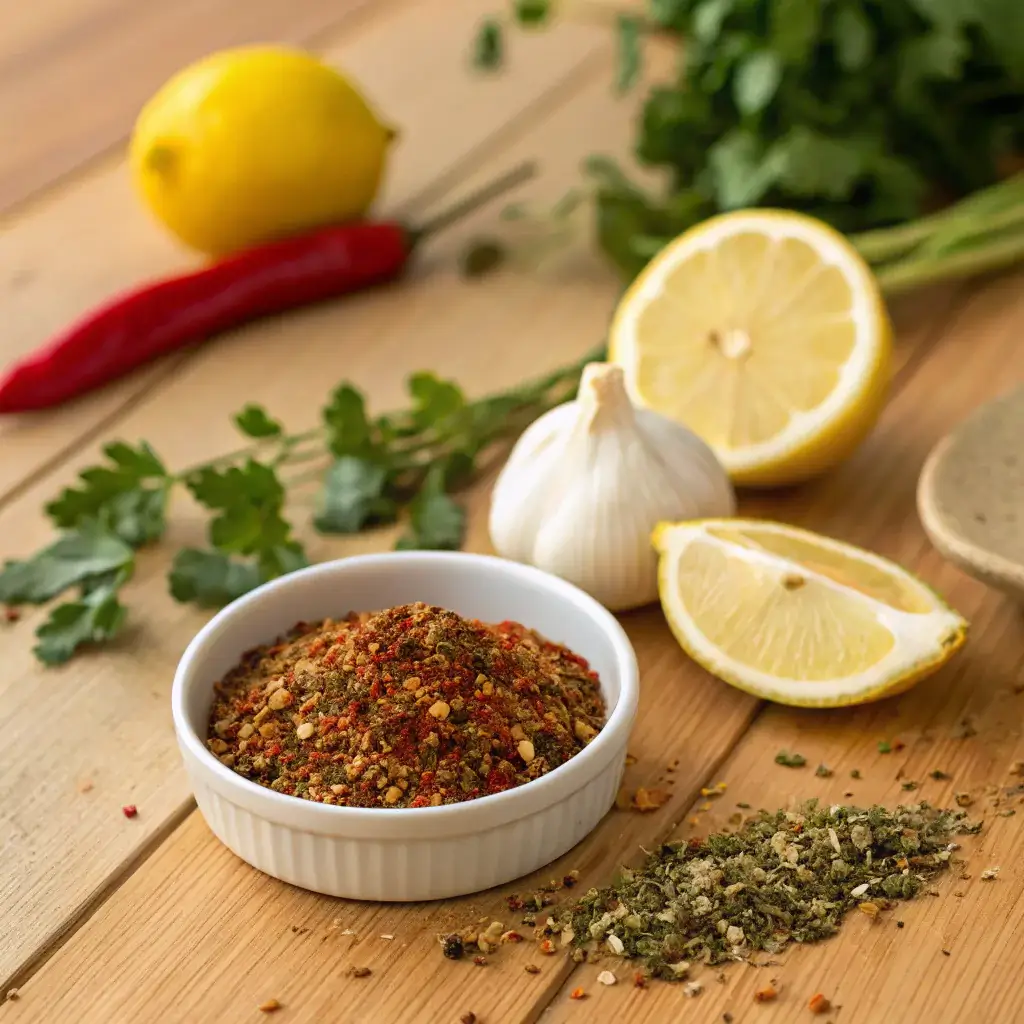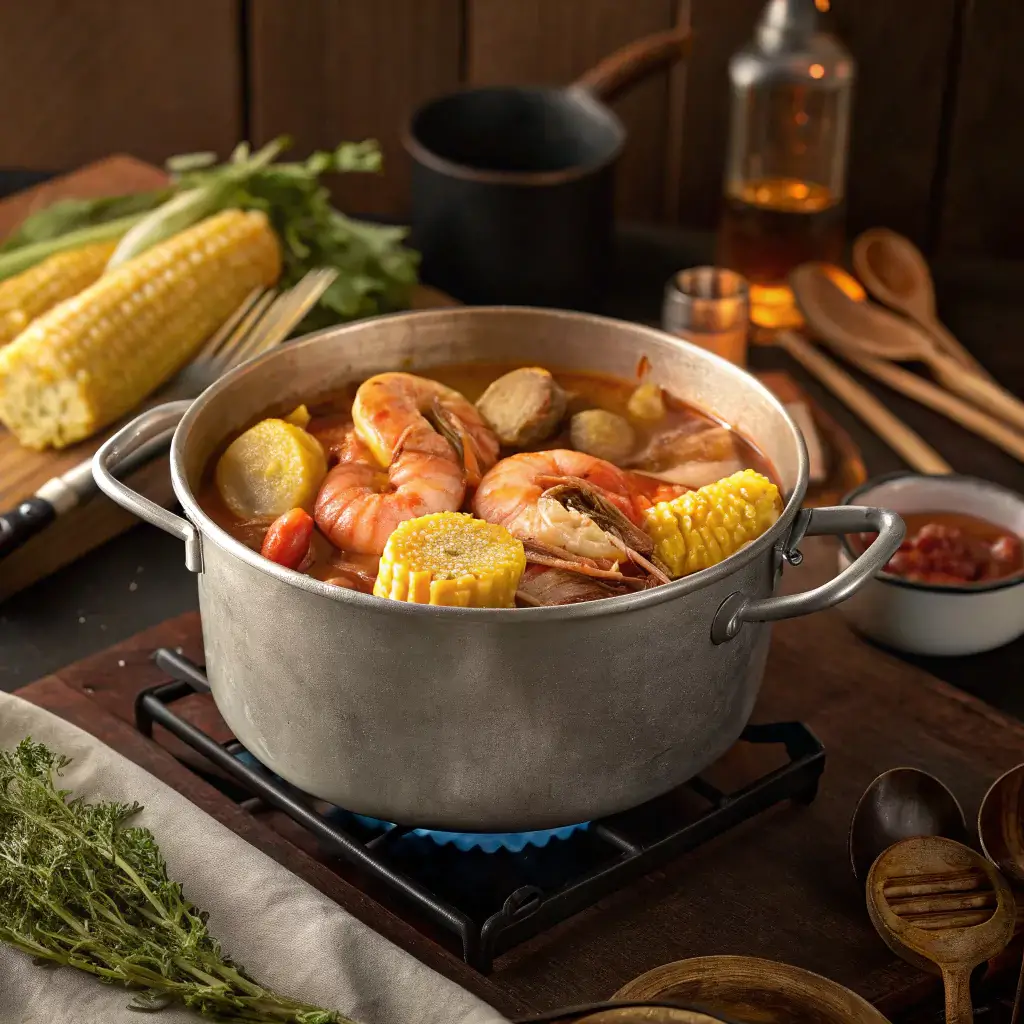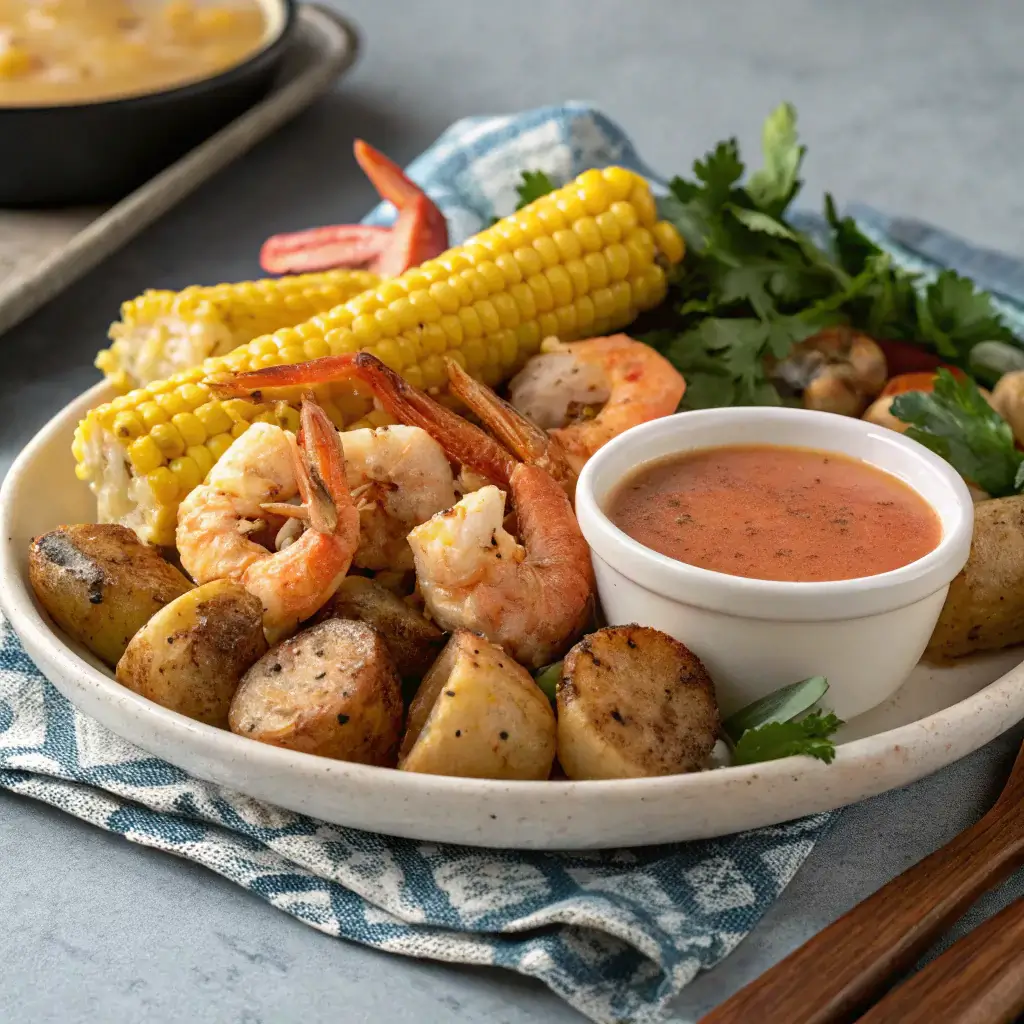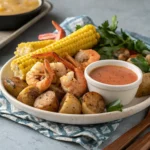Is Seafood Boil Cajun or Creole?

Introduction
Seafood boils are more than just a meal—they’re a celebration of community, culture, and incredible flavors. From backyard gatherings to festive holiday spreads, this southern classic has become a beloved tradition across the United States. But at the heart of this dish lies a question that sparks culinary debates: Is a seafood boil Cajun or Creole?
Both Cajun and Creole cuisines have shaped Louisiana’s food scene, blending unique ingredients and cooking techniques that make their flavors unforgettable. While they share common roots, Cajun and Creole seafood boils differ in their use of spices, vegetables, and preparation methods.
In this article, we’ll dive into the cultural origins of seafood boils, explore how Cajun and Creole influences set them apart, and answer common questions about this iconic dish. Plus, we’ll provide tips on pairing seafood boils with sauces like this Seafood Boil Sauce or complementary dishes like Steelhead Trout for a complete southern feast.
Table of Contents
The Roots of Seafood Boils
The Cajun Connection
Cajun seafood boils trace their roots back to the French Acadians who settled in Louisiana during the 18th century. These resourceful farmers and fishers embraced the abundant seafood in the region, creating bold, spicy dishes using simple, locally sourced ingredients. Cajun boils are known for their heavy use of garlic, paprika, cayenne, and other spices that pack a punch.
The Creole Influence
Creole cuisine, on the other hand, is a melting pot of French, Spanish, African, and Caribbean flavors. Creole seafood boils often include tomatoes, herbs like thyme and oregano, and a wider variety of seasonings. The Creole approach tends to be more refined, with an emphasis on layered, aromatic flavors.
Shared Traditions in Southern Cooking
Despite their differences, Cajun and Creole cooking share one key element: their celebration of seafood. From shrimp and crawfish to crab and lobster, both styles honor the natural bounty of Louisiana’s waters. And whether you prefer the bold heat of Cajun spices or the aromatic complexity of Creole flavors, a seafood boil always brings people together.
What Sets Cajun and Creole Seafood Boils Apart?
Key Ingredients in Cajun Seafood Boils
Cajun seafood boils are defined by their bold, spicy flavors and simple, rustic ingredients. Key elements include:

- Spices: Paprika, cayenne, garlic powder, onion powder, and black pepper are the backbone of Cajun seasoning.
- Vegetables: Corn on the cob and red potatoes are staple additions, absorbing the rich flavors of the boil.
- Seafood: Crawfish, shrimp, and crab are the most commonly used, reflecting Louisiana’s abundance of fresh seafood.
Cajun boils focus on bringing out the natural sweetness of seafood with a heavy dose of spice, making them a favorite for heat lovers.
The Unique Flavors of Creole Seafood Boils
Creole seafood boils offer a more refined and aromatic flavor profile, often incorporating a wider range of ingredients:
- Tomatoes: A signature addition that adds depth and a touch of acidity.
- Herbs: Thyme, oregano, and parsley give Creole boils a balanced, herbaceous quality.
- Butter: Creole recipes often use butter as a base for sauces, adding richness to the dish.
While Creole boils still celebrate seafood, their seasoning leans less spicy and more aromatic, making them a great choice for milder palates.
Cooking Techniques That Define Each Style
The preparation methods also set Cajun and Creole boils apart:
- Cajun Boils: Ingredients are often boiled together in large pots with plenty of seasoning, then poured onto a communal table for everyone to enjoy.
- Creole Boils: These are often served with sauces or stews, like a Creole butter sauce, for a layered and luxurious flavor experience.

If you’re looking to experiment, try pairing your seafood boil with a Seafood Boil Sauce for extra flavor, or serve it alongside a dish like Steelhead Trout to add variety to your meal.
With their distinct flavors and techniques, Cajun and Creole boils offer something for everyone—whether you’re craving spice or subtle complexity.
Louisiana Seafood Boils and Their Cultural Significance
The Role of Seafood Boils in Cajun Culture
Seafood boils are deeply embedded in Cajun culture, reflecting the resourcefulness and communal spirit of the French Acadian settlers. Cajun boils are often informal, family-centered gatherings where the food is as much about connection as it is about flavor.
- Crawfish Boils: A quintessential Cajun event, featuring spicy crawfish cooked with potatoes, corn, and a bold seasoning mix.
- Outdoor Tradition: Cajun boils are typically cooked outdoors in large pots, with everyone gathering around to eat directly from a communal spread.
How Creole Traditions Shape the Dish
In Creole culture, seafood boils reflect the fusion of influences from French, Spanish, African, and Caribbean cuisines. Creole boils often include a wider variety of ingredients and are served in a slightly more formal setting.
- Diverse Ingredients: You’re more likely to find additions like okra, tomatoes, and even sausages in a Creole boil.
- Focus on Sauces: Creole boils often come with rich sauces, like a buttery Creole dipping sauce, that add depth and richness to the dish.
What Is a Seafood Boil Called in Louisiana?
In Louisiana, seafood boils are often referred to simply as “crawfish boils” or “crab boils,” depending on the primary seafood used. These events are less about the terminology and more about the experience—a celebration of food, family, and friends.
- Crawfish Season: Crawfish boils are particularly popular during crawfish season (spring and early summer), making them a hallmark of Louisiana’s culinary calendar.
- Community Gatherings: Boils are often held for holidays, birthdays, or casual get-togethers, emphasizing the social aspect of the meal.
To embrace the full spirit of a Louisiana seafood boil, serve your feast with sides like coleslaw or cornbread and pair it with a complementary dish like Steelhead Trout for a well-rounded spread.
Seafood boils in Louisiana are more than a meal—they’re a way of life, connecting communities through shared flavors and traditions.
The Evolution of Seafood Boils Across the U.S.
Modern Interpretations of the Seafood Boil
Seafood boils have evolved far beyond their Louisiana roots, becoming a nationwide favorite. Modern interpretations often incorporate unique twists while keeping the communal spirit intact:
- Fusion Flavors: Restaurants and home cooks alike experiment with Asian-inspired sauces like garlic butter with soy or gochujang for a Korean kick.
- Customizable Boils: Many boils now offer a “choose your own adventure” approach, letting diners pick their preferred seafood, spices, and sauce combinations.
- Diet-Friendly Options: Low-carb seafood boils served with cauliflower rice or extra veggies are popular among health-conscious foodies.
Regional Variations Outside of Louisiana
Seafood boils have taken on regional identities as they spread across the U.S.:
- Lowcountry Boil (South Carolina and Georgia): Known for its milder seasoning, this boil features shrimp, sausage, corn, and potatoes.
- New England Clambake: A seafood boil featuring clams, mussels, lobster, and corn, often cooked over a bed of seaweed.
- Texas Gulf Coast Boils: Influenced by Cajun traditions but with a Tex-Mex twist, featuring bold flavors and additions like jalapeños.
Influences from Diverse Cultures
As seafood boils gain global appeal, they’ve been shaped by diverse cultural influences:
- Asian American Influence: Asian-inspired sauces and spices, such as Thai chili or ginger-garlic butter, add bold, tangy flavors.
- Caribbean Fusion: Tropical flavors like coconut milk and allspice bring a new dimension to seafood boils in regions with Caribbean heritage.
- Pacific Northwest Variations: In areas like Seattle, seafood boils often include Dungeness crab and salmon, reflecting the local catch.
While Cajun and Creole seafood boils remain iconic, don’t be afraid to explore regional variations and add your own flair. Pairing your boil with a side of buttery Seafood Boil Sauce ensures a flavorful finish to any version.
From coastal traditions to creative adaptations, seafood boils continue to grow in popularity as a versatile, crowd-pleasing meal that celebrates the bounty of the sea.
Pairing Your Seafood Boil with Complementary Dishes
Side Dishes for Cajun and Creole Boils
A seafood boil is a hearty dish on its own, but the right side dishes can elevate the meal even further. Popular options include:
- Cornbread: A sweet and crumbly side that balances the bold spices of a Cajun boil.
- Coleslaw: Crisp and tangy, it provides a refreshing contrast to the rich seafood.
- Garlic Bread: Perfect for soaking up the flavorful sauces and juices from the boil.
- Potato Salad: A classic, creamy side that pairs well with the robust flavors of the boil.
Sauces That Elevate the Feast
No seafood boil is complete without a variety of dipping sauces to enhance the flavors.
- Garlic Butter Sauce: A simple yet flavorful addition to any boil.
- Spicy Mayo: For those who enjoy a creamy, tangy kick.
- Cajun Seafood Boil Sauce: Drizzle it over your seafood or use it as a dip. Learn how to make it with our Seafood Boil Sauce Recipe for the perfect complement to your meal.
Drinks to Complete the Meal
Pairing the right drink with your seafood boil adds a refreshing element to the meal.
- Lemonade: The citrusy brightness cuts through the richness of the boil.
- Beer: A cold lager or wheat beer complements the bold spices of a Cajun boil.
- Iced Tea: A classic southern pairing that balances the heat of the dish.
For a seafood boil with a twist, serve it alongside a Steelhead Trout dish. The buttery texture and unique flavor of trout make it a great addition to any seafood spread.
By adding thoughtful pairings to your boil, you can create a memorable dining experience that highlights the best of Cajun and Creole flavors.


Cajun Seafood Boil
- Total Time: 45 minutes
- Yield: 1 large seafood boil 1x
Description
Dive into the bold and spicy flavors of the South with this classic Cajun Seafood Boil. Packed with fresh seafood, hearty vegetables, and a medley of vibrant Cajun spices, this dish is perfect for bringing people together. Whether you’re hosting a summer feast or a cozy gathering, this recipe promises to deliver a mouthwatering and memorable dining experience.
Ingredients
- 4 quarts water
- 1/2 cup Cajun seasoning (plus extra for sprinkling)
- 1 tablespoon smoked paprika
- 1 tablespoon cayenne pepper (adjust for spice preference)
- 1 lemon, halved
- 4 garlic cloves, smashed
- 1 large onion, quartered
- 1 lb red potatoes
- 4 ears of corn, halved
- 1 lb smoked sausage, sliced
- 1 lb shrimp, deveined and shell-on
- 1 lb crab legs or crawfish (optional)
- 4 tablespoons unsalted butter, melted
- Fresh parsley, chopped (for garnish)
Instructions
- In a large stockpot, bring water to a boil. Add Cajun seasoning, paprika, cayenne pepper, lemon halves, garlic, and onion. Stir well.
- Reduce heat to a simmer and let the broth cook for 10 minutes to allow the flavors to develop.
- Add potatoes to the pot and cook for 10 minutes.
- Add corn and sausage slices, cooking for an additional 5 minutes.
- Gently stir in shrimp and crab (if using), cooking until shrimp are pink and opaque, about 3–5 minutes.
- Drain the pot, reserving some broth for dipping if desired. Spread the seafood boil onto a large serving tray or newspaper-lined table for communal dining.
- Drizzle with melted butter, sprinkle extra Cajun seasoning, and garnish with fresh parsley. Serve immediately with dipping sauces like garlic butter or Cajun seafood sauce.
Notes
- Adjust the cayenne pepper and Cajun seasoning to control the heat level.
- For an authentic experience, serve the seafood boil on butcher paper for a fun, mess-free cleanup.
- Pair with coleslaw, cornbread, or garlic bread for a complete Southern feast.
- Prep Time: 15 minutes
- Cook Time: 30 minutes
Nutrition
- Serving Size: 4–6 servings
- Calories: 450
- Fat: 20g
- Carbohydrates: 35g
- Protein: 35g
Frequently Asked Questions About Seafood Boils
What Ethnicity Is Seafood Boil?
Seafood boils are a hallmark of southern American cuisine, deeply rooted in Cajun and Creole cultures. These culinary traditions reflect the diverse ethnic influences of Louisiana, blending French, Spanish, African, and Caribbean elements. Over time, the seafood boil has evolved into a celebration of local ingredients and community gatherings, becoming a cultural symbol of the South.
Is Crawfish Boil Cajun or Creole?
A crawfish boil can be either Cajun or Creole, depending on the ingredients and preparation style:
Cajun Crawfish Boil: Features bold, spicy flavors, with crawfish boiled in heavily seasoned water alongside potatoes, corn, and sausage.
Creole Crawfish Boil: May include additional ingredients like tomatoes and herbs, creating a milder, more aromatic dish.
Both styles are delicious and showcase the rich culinary heritage of Louisiana.
What Culture Is Seafood Boil?
Seafood boils are most closely associated with Louisiana’s Cajun and Creole cultures. However, similar dishes exist in other coastal regions and cultures, such as New England clambakes and Lowcountry boils from the Carolinas. These dishes share a common theme of celebrating fresh, local seafood in a communal setting.
What Is a Seafood Boil Called in Louisiana?
In Louisiana, seafood boils are often referred to by the primary seafood featured, such as:
Crawfish Boil: The most iconic type, especially during crawfish season.
Crab Boil: A popular choice featuring blue crabs or snow crabs.
Regardless of the name, Louisiana seafood boils are more about the shared experience and bold flavors than strict definitions.
Add a side of buttery Seafood Boil Sauce to complement your boil, or try a flavorful twist with Steelhead Trout to diversify your seafood spread.
These FAQs highlight the rich history and adaptability of seafood boils, making them a dish worth celebrating in any culture or setting.
Conclusion
Seafood boils are a beloved culinary tradition with deep roots in Cajun and Creole cultures, offering a delicious and communal way to enjoy the bounty of the sea. Whether you prefer the bold, spicy flavors of a Cajun boil or the refined, aromatic touch of a Creole boil, there’s no denying the rich cultural heritage that makes this dish special.
From crawfish boils in Louisiana to modern seafood feasts across the U.S., seafood boils have evolved while staying true to their core: a celebration of food, family, and community. By exploring the differences in seasoning, preparation, and cultural influences, you can create a seafood boil that reflects your tastes and traditions.
To complete your seafood boil experience, don’t forget to pair it with flavorful accompaniments. Try a rich Seafood Boil Sauce for dipping, or add variety to your meal with dishes like Steelhead Trout.
Now it’s your turn to embrace the art of the seafood boil! Whether you’re hosting a family gathering or simply treating yourself to a flavorful feast, this dish is a perfect way to bring people together and celebrate the vibrant flavors of the South.

